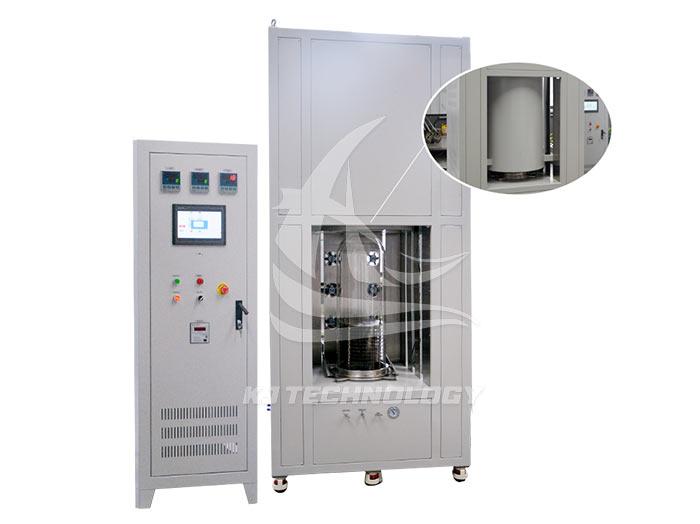Precautions for selecting gas quenching furnace
 10-27-2025 Author: KJ technology
10-27-2025 Author: KJ technology
When choosing a gas quenching furnace, it is necessary to comprehensively consider multiple factors such as equipment performance, process adaptability, cost-effectiveness, and safety to ensure that production needs are met and heat treatment quality is improved. The following are specific precautions and analysis:
1. Core performance parameters
Temperature control accuracy
Importance: Temperature fluctuations directly affect the transformation of metal structure. If the quenching temperature deviation exceeds ± 5 ℃, it may lead to substandard hardness or cracking.
Selection suggestion: Prioritize equipment equipped with PID intelligent temperature control system and thermocouple multi-point monitoring to ensure temperature uniformity of ≤± 5 ℃.
Case: Due to insufficient temperature control accuracy, a certain automotive parts factory experienced significant fluctuations in the hardness of gears after quenching, resulting in an increase in rework rate.
Gas cooling capacity
Key indicators: cooling rate, gas pressure range, gas type (nitrogen, helium, etc.).
Suggestion for selection:
High strength steel requires rapid cooling with high-pressure gas;
Thin walled or precision parts can choose low-pressure gas to reduce deformation.
Case: A certain aerospace company used 2MPa high-pressure nitrogen quenching to reduce the residual austenite content of high-temperature alloy blades and significantly improve their performance.
Vacuum degree and sealing performance
Importance: Vacuum environment can avoid oxidation and decarburization, especially suitable for materials such as stainless steel and titanium alloys.
Suggestion for selection:
The vacuum degree needs to reach the level of 10 ⁻² -10 ⁻³ Pa;
Pay attention to the sealing design of furnace doors, observation windows, and other parts to prevent air leakage.
Case: Due to insufficient vacuum degree in a certain mold factory, the surface of H13 steel die-casting mold oxidized, resulting in size deviation after polishing and an increase in scrap rate.
2. Process adaptability
Material Compatibility
Consideration factors: Whether the equipment supports various materials such as carbon steel, alloy steel, stainless steel, titanium alloy, high-temperature alloy, etc.
Suggestion for selection:
Confirm the maximum heating temperature of the equipment (usually ≥ 1200 ℃);
Ask the supplier if they provide a material process database or customized quenching curve service.
Case: A new energy enterprise needs to process nickel based high-temperature alloys and selects equipment that supports high temperatures of 1250 ℃, successfully achieving precise control of the γ 'phase.
Workpiece size and loading capacity
Key parameters: effective heating zone size, maximum workpiece weight, furnace loading method (single-layer/multi-layer).
Suggestion for selection:
Select equipment capacity based on production batch to avoid "big horse pulling small car" or overloading operation;
Consider automated loading and unloading systems to improve efficiency.
Case: Due to the small heating area of the equipment, a gear factory needs to process in batches, resulting in an extended production cycle.
Process flexibility
Functional requirement: Does it support complex processes such as segmented quenching, isothermal quenching, and graded quenching.
Suggestion for selection:
Priority should be given to devices controlled by programmable logic controllers (PLCs) or industrial computers (IPC);
Confirm if multiple temperature time curve settings are supported.
Case: A certain cutting tool factory achieves the optimal balance between hardness and toughness of high-speed steel cutting tools through segmented quenching process.
3. Cost and benefit analysis
Initial investment and operating costs
Comparison items: equipment price, energy consumption (electricity/gas), maintenance cost, spare parts cost.
Suggestion for selection:
Small and medium-sized enterprises can choose economical equipment, but they need to ensure that the core performance meets the standards;
Large enterprises can invest in high-end equipment to reduce long-term costs through energy-saving designs such as waste heat recovery.
Production efficiency and capacity
Key indicators: heating speed, cooling time, furnace loading capacity.
Suggestion for selection:
Rapid heating can shorten the cycle;
Large capacity equipment is suitable for mass production, but it needs to balance the cost per unit.
Case: A certain bearing factory has upgraded its equipment, shortened the processing time of a single furnace, and increased its production capacity.
4. Safety and reliability
Security protection design
Essential functions: Over temperature alarm, gas leak detection, emergency stop button, explosion-proof device.
Suggestion for selection:
Confirm whether the equipment has passed safety certifications such as CE and ISO;
Ask the supplier if they provide safety training services.
Case: A factory failed to install a gas leak detection device, resulting in a nitrogen leak and suffocation accident, causing casualties.
Equipment stability and lifespan
Inspection points: furnace body material (such as stainless steel liner), heating element type (resistance wire/induction coil), and cooling system reliability.
Suggestion for selection:
Prioritize brand equipment and refer to user reputation;
Require suppliers to provide warranty period and after-sales service commitments.
Case: A certain mold factory used low-priced equipment, and within one year, the heating elements were frequently damaged, resulting in repair costs exceeding the equipment price.
5. After sales service and technical support
Supplier capability
Evaluation items: installation and debugging, process training, spare parts supply, remote fault diagnosis.
Suggestion for selection:
Prioritize suppliers who provide turnkey projects;
Confirm if 24-hour emergency service is supported.
Upgrade and Scalability
Future demand: Does it support software upgrades and hardware extensions (such as adding gas nozzles).
Suggestion for selection:
Reserved interfaces to adapt to new technologies (such as IoT monitoring);
Inquire with the supplier if they offer a trade in service.








